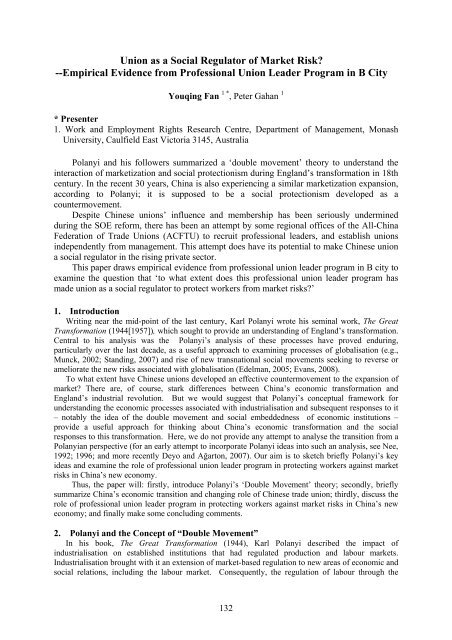Workshop proceeding - final.pdf - Faculty of Information and ...
Workshop proceeding - final.pdf - Faculty of Information and ...
Workshop proceeding - final.pdf - Faculty of Information and ...
Create successful ePaper yourself
Turn your PDF publications into a flip-book with our unique Google optimized e-Paper software.
Union as a Social Regulator <strong>of</strong> Market Risk?<br />
--Empirical Evidence from Pr<strong>of</strong>essional Union Leader Program in B City<br />
Youqing Fan 1 * , Peter Gahan 1<br />
* Presenter<br />
1. Work <strong>and</strong> Employment Rights Research Centre, Department <strong>of</strong> Management, Monash<br />
University, Caulfield East Victoria 3145, Australia<br />
Polanyi <strong>and</strong> his followers summarized a ‘double movement’ theory to underst<strong>and</strong> the<br />
interaction <strong>of</strong> marketization <strong>and</strong> social protectionism during Engl<strong>and</strong>’s transformation in 18th<br />
century. In the recent 30 years, China is also experiencing a similar marketization expansion,<br />
according to Polanyi; it is supposed to be a social protectionism developed as a<br />
countermovement.<br />
Despite Chinese unions’ influence <strong>and</strong> membership has been seriously undermined<br />
during the SOE reform, there has been an attempt by some regional <strong>of</strong>fices <strong>of</strong> the All-China<br />
Federation <strong>of</strong> Trade Unions (ACFTU) to recruit pr<strong>of</strong>essional leaders, <strong>and</strong> establish unions<br />
independently from management. This attempt does have its potential to make Chinese union<br />
a social regulator in the rising private sector.<br />
This paper draws empirical evidence from pr<strong>of</strong>essional union leader program in B city to<br />
examine the question that ‘to what extent does this pr<strong>of</strong>essional union leader program has<br />
made union as a social regulator to protect workers from market risks?’<br />
1. Introduction<br />
Writing near the mid-point <strong>of</strong> the last century, Karl Polanyi wrote his seminal work, The Great<br />
Transformation (1944[1957]), which sought to provide an underst<strong>and</strong>ing <strong>of</strong> Engl<strong>and</strong>’s transformation.<br />
Central to his analysis was the Polanyi’s analysis <strong>of</strong> these processes have proved enduring,<br />
particularly over the last decade, as a useful approach to examining processes <strong>of</strong> globalisation (e.g.,<br />
Munck, 2002; St<strong>and</strong>ing, 2007) <strong>and</strong> rise <strong>of</strong> new transnational social movements seeking to reverse or<br />
ameliorate the new risks associated with globalisation (Edelman, 2005; Evans, 2008).<br />
To what extent have Chinese unions developed an effective countermovement to the expansion <strong>of</strong><br />
market? There are, <strong>of</strong> course, stark differences between China’s economic transformation <strong>and</strong><br />
Engl<strong>and</strong>’s industrial revolution. But we would suggest that Polanyi’s conceptual framework for<br />
underst<strong>and</strong>ing the economic processes associated with industrialisation <strong>and</strong> subsequent responses to it<br />
– notably the idea <strong>of</strong> the double movement <strong>and</strong> social embeddedness <strong>of</strong> economic institutions –<br />
provide a useful approach for thinking about China’s economic transformation <strong>and</strong> the social<br />
responses to this transformation. Here, we do not provide any attempt to analyse the transition from a<br />
Polanyian perspective (for an early attempt to incorporate Polanyi ideas into such an analysis, see Nee,<br />
1992; 1996; <strong>and</strong> more recently Deyo <strong>and</strong> Ağarton, 2007). Our aim is to sketch briefly Polanyi’s key<br />
ideas <strong>and</strong> examine the role <strong>of</strong> pr<strong>of</strong>essional union leader program in protecting workers against market<br />
risks in China’s new economy.<br />
Thus, the paper will: firstly, introduce Polanyi’s ‘Double Movement’ theory; secondly, briefly<br />
summarize China’s economic transition <strong>and</strong> changing role <strong>of</strong> Chinese trade union; thirdly, discuss the<br />
role <strong>of</strong> pr<strong>of</strong>essional union leader program in protecting workers against market risks in China’s new<br />
economy; <strong>and</strong> <strong>final</strong>ly make some concluding comments.<br />
2. Polanyi <strong>and</strong> the Concept <strong>of</strong> “Double Movement”<br />
In his book, The Great Transformation (1944), Karl Polanyi described the impact <strong>of</strong><br />
industrialisation on established institutions that had regulated production <strong>and</strong> labour markets.<br />
Industrialisation brought with it an extension <strong>of</strong> market-based regulation to new areas <strong>of</strong> economic <strong>and</strong><br />
social relations, including the labour market. Consequently, the regulation <strong>of</strong> labour through the<br />
132
















